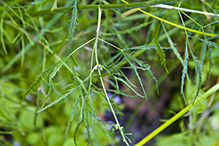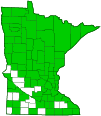bulbet-bearing water hemlock
(Cicuta bulbifera)
Conservation • Wetland • Description • Habitat • Ecology • Use • Distribution • Taxonomy
Description |
||
Bulbet-bearing water hemlock is a 12″ to 40″ tall, erect, perennial forb that rises on one or more stems from several fleshy, tuberous roots. The foliage has a foul smell. The stems are erect, occasionally branched, slender, light green or reddish-green, hairless, hollow, and often covered with a whitish, waxy bloom (glaucous). They may be green or purple. Mature stems are green with purple spots or stripes. The base of the stem is enlarged. The lower leaves are alternate and are divided into 3 segments. Each segment may be again divided into 3 sections. Each ultimate section is divided into usually 3, sometimes 5 leaflets (pinnately compound). The lower leaves are up to 6″ long, up to 4″ wide, and on long leaf stalks, becoming progressively much smaller, less divided, and on shorter leaf stalks as they ascend the stem. The uppermost leaves are stalkless and sometimes undivided. The leaf stalks form a sheath at the base that wraps around the stem. The leaf nodes are purplish. The ultimate leaflets are narrowly lance-shaped, green, hairless, ¾″ to 3½″ long, and no more than 3 ⁄16″ wide. They are often folded upward along the main vein. The margins have widely-spaced, ragged teeth, or are sometimes cut about halfway to the midrib into narrow lobes. The radial veins of the leaflet extend to the notches between the teeth, not to the tips of the teeth as in other members of the carrot family. There are clusters of stalkless, egg-shaped bulblets in the axils of the upper leaves. The inflorescence is a compound, umbrella-shaped cluster (umbel) at the end of the stem and branches. The umbel is round, 1″ to 2″ in diameter, and has 8 to 20 slender, ½″ to 1″ long branches (rays). There is no bract at the base of the umbel. At the end of each ray is a smaller, secondary, ⅜″ to ⅝″ wide umbel (umbellet). There are 11 to 19 or more individual flowers in each umbellet. The umbellet is not subtended by bracts. The flowers are about ⅛″ wide and are composed of 5 green sepals, 5 white petals, 5 white stamens, 2 styles, and an ovary. The petals are rounded, erect to spreading, and notched at the tip. There is no fragrance. The fruit is dry, 1 ⁄16″ to ⅛″ long, egg-shaped to globular capsule containing 2 seeds. These are the previously mentioned bulbils in the upper leaf axils. They ripen from August to September, splitting into 2 one-seeded segments. |
||
Height |
||
12″ to 40″ |
||
Flower Color |
||
White |
||
Similar Species |
||
| In water hemlocks (Cicuta spp.) the radial veins of each leaflet extend to the notches in the leaflet margin, not to the tips of the teeth, as they do with other members of the carrot family. | ||
Habitat |
||
Wet. Marshes, streambanks, lake shores. |
||
Ecology |
||
Flowering |
||
July to September |
||
Pests and Diseases |
||
|
||
Use |
||
|
||
Distribution |
||||
|
Sources |
|||
| 2/27/2023 | ||||
Nativity |
||||
Native |
||||
Occurrence |
||||
|
||||
Taxonomy |
|||
| Kingdom | Plantae (Plants) | ||
| Division | Tracheophyta (Vascular Plants) | ||
| Subdivision | Spermatophytina (Seed Plants) | ||
| Class | Magnoliopsida (Dicots) | ||
Order |
Apiales (Carrots, Ivies, and Allies) | ||
| Suborder | Apiineae | ||
Family |
Apiaceae (carrot) | ||
| Subfamily | Apioideae | ||
| Tribe | Oenantheae | ||
Genus |
Cicuta (water hemlocks) | ||
Subordinate Taxa |
|||
|
|||
Synonyms |
|||
|
|||
Common Names |
|||
bulb waterhemlock bulbiferous water-hemlock bulblet water-hemlock bulblet-bearing water hemlock bulblet-bearing water-hemlock |
|||
Glossary
Axil
The upper angle where a branch, stem, leaf stalk, or vein diverges.
Sepal
An outer floral leaf, usually green but sometimes colored, at the base of a flower.
Glaucous
Pale green or bluish gray due to a whitish, powdery or waxy film, as on a plum or a grape.
Ray
A strap-shaped flower, or the strap-shaped portion of a flower, in the Asteraceae (aster) family. A branch of an umbel in the Apiaceae (carrot) family.
Umbel
A flat-topped or convex, umbrella-shaped cluster of flowers or buds arising from more or less a single point.
Umbellet
A secondary umbel in a compound umbel.
Visitor Photos |
|||||
Share your photo of this plant. |
|||||
| This button not working for you? Simply email us at info@MinnesotaSeasons.com. Attach one or more photos and, if you like, a caption. |
|||||
|
|||||
MinnesotaSeasons.com Photos |
|||||
 |
|||||

Slideshows |
||

Visitor Videos |
|||
Share your video of this plant. |
|||
| This button not working for you? Simply email us at info@MinnesotaSeasons.com. Attach a video, a YouTube link, or a cloud storage link. |
|||
Other Videos |
|||

Visitor Sightings |
|||||
Report a sighting of this plant. |
|||||
| This button not working for you? Simply email us at info@MinnesotaSeasons.com. Be sure to include a location. |
|||||
|
|||||
MinnesotaSeasons.com Sightings |
|||||

|
Created: Last Updated: © MinnesotaSeasons.com. All rights reserved. |
